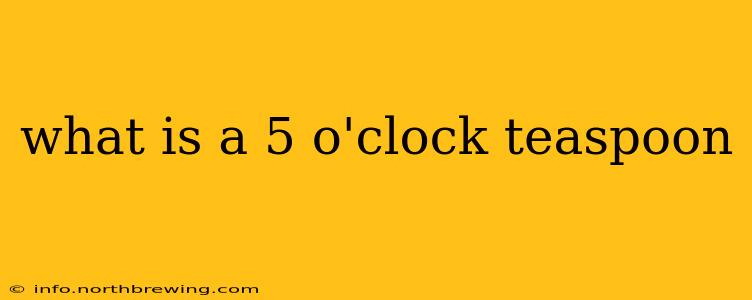What is a 5 O'Clock Teaspoon?
The term "5 o'clock teaspoon" isn't a standardized measurement like a tablespoon or teaspoon found in typical cooking recipes. Instead, it refers to a specific type of teaspoon, usually associated with vintage or antique silverware and characterized by its elegant design and often smaller size compared to modern teaspoons.
The name itself evokes a sense of formality and tradition, suggesting its use during a refined afternoon tea service. The "5 o'clock" designation points to the traditional time for afternoon tea in many cultures. While there isn't a universally agreed-upon size, these teaspoons are generally smaller and more delicate than the standard teaspoons we use today for measuring ingredients.
What are the characteristics of a 5 o'clock teaspoon?
- Smaller Size: They're typically smaller than a standard teaspoon, often holding less than 5ml of liquid.
- Ornate Design: They frequently feature intricate detailing, including decorative handles, elaborate bowls, or engraved patterns. These designs often reflect the style of the era in which they were crafted (e.g., Victorian, Art Deco).
- High-Quality Materials: They're usually made from high-quality materials like sterling silver, silver plate, or other fine metals.
- Collectible Value: Due to their age, design, and materials, antique 5 o'clock teaspoons can hold considerable collectible value.
What is the difference between a 5 o'clock teaspoon and a regular teaspoon?
The main differences lie in size, design, and intended use. A regular teaspoon is primarily a functional tool for measuring and consuming food, while a 5 o'clock teaspoon is more of a decorative and ceremonial item, used specifically within a more formal tea-drinking context. A regular teaspoon is standardized for measurement (approximately 5ml), whereas the volume of a 5 o'clock teaspoon is highly variable depending on the piece.
How do I measure with a 5 o'clock teaspoon?
Because the size of a 5 o'clock teaspoon isn't standardized, it's not recommended for precise measurements in cooking or baking. If you need accurate measurements, always use a standard measuring teaspoon. A 5 o'clock teaspoon's function is primarily aesthetic and ceremonial, not precise measurement.
Where can I find a 5 o'clock teaspoon?
You're most likely to find these teaspoons at:
- Antique shops and markets: These are great places to discover unique and vintage examples.
- Online auction sites: Sites like eBay often list vintage silverware, including 5 o'clock teaspoons.
- Estate sales: Check local estate sales for potential finds.
In conclusion, a "5 o'clock teaspoon" isn't defined by a specific measurement but rather by its aesthetic qualities and association with a traditional afternoon tea ritual. Its value lies in its elegance and historical significance, rather than its precision for culinary measurements.
